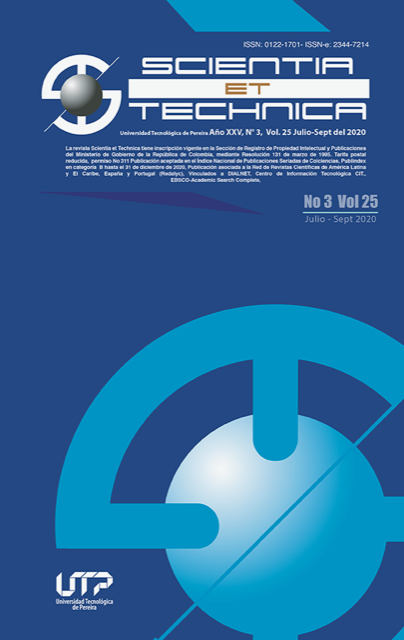Ordinary least squares method: A strategy to reduce the mass measurement uncertainty
DOI:
https://doi.org/10.22517/23447214.23671Keywords:
buoyancy factor, gravity acceleration ratio, mass and balance, measurement uncertainty, metrologyAbstract
This research was motivated by technical-economic challenges imposed by mass metrology, in particular on issues concerning calibration methods of non-automatic weighing instruments (i.e.: scales). In the contemporary world it is vital to ensure the reliability of measurement results in a test, testing and research laboratory. These results must be reproduced by institutions –—National and International— considering the uncertainties associated with the process. Two of the factors that strongly affect the metrological reliability of the mass measurement processes are: (i) non-frequency of calibration of scales; (ii) analytical methods for the treatment of experimental data obtained in the calibration. In this context, and maintaining the principles for the calibration of a measuring instrument in which it must be performed under the same operating conditions of the instrument, metrology laboratories are in need of knowing metrological reliability (i.e.: errors and uncertainties) for each calibration scenario. In this order of ideas, this study sought to evaluate the incident factors in the measurement of mass and calibration of non-automatic weighing instruments. The applied methodology (ordinary least squares method) allowed estimating the metrological reliability of a Digital Scale (Max. Cap.: 30 kg; Res.: 0.001 kg) at 0.012% (k = 2). The results confirmed that the applied method allowed to reduce the adjustment uncertainty up to 92.0% from the use of a fourth degree polynomial when compared to a model widely used by conventional metrology laboratories, i.e.: first degree polynomial to from a simple linear regression.
Downloads
References
OIML R-76-1. "Non-automatic weighing instruments. Part 1: Metrological and technical requirements - Tests" International Organization. of Legal Metrology. International Recommendation. 2006.
OIML R-111-1. "Weights of classes E1, E2, F1, F2, M1, M1-2, M2, M2-3 and M3. Part 1: Metrological and technical requirement" International Organization. of Legal Metrology. International Recommendation. 2004.
R. Engel and H. Baade, "Water density determination in high-accuracy flowmeter calibration - Measurement uncertainties and practical aspects" Flow Measurement and Instrumentation, vol. 25, pp. 40-53, June 1997. DOI: 10.1016/j.flowmeasinst.2011.05.002
https://doi.org/10.1016/j.flowmeasinst.2011.05.002
EURAMET cg-18. "Guidelines on the Calibration of Non-Automatic Weighing Instruments" European Association of National Metrology Institutes. International Guide. 2015.
C. Rapalino, J. Tapias, "Evaluación de la confiabilidad metrológica de los instrumentos no automáticos de pesaje en los laboratorios de la Universidad del Atlántico". Universidad del Atlántico, Facultad de Ingeniería-Programa de Ingeniería Mecánica, Colombia. 2016.
C. Rapalino, J. Tapias, C. Pedraza C, J. Hernandez, I. Ibañez, "Factor de empuje y aceleración de gravedad: dos parámetros críticos en la calibración de balanzas" Simposio CENAM Metrología para el bienestar y la competitividad, septiembre 2016.
GUM. "Guide to the Expression of Uncertainty in Measurement, (1995), with Supplement 1, Evaluation of measurement data, JCGM 101:2008" International Standard Organization (ISO). 2008.
V. Wylen and R. Sonntag "Fundamentals of Classical Thermodynamics" (SI Version). Ed. John Wiley & Sons: Singapore, 3ra. edición, 1985.
Downloads
-
Vistas(Views): 907
- PDF (Español (España)) Descargas(Downloads): 401
Published
How to Cite
Issue
Section
License
Copyrights
The journal is free open access. The papers are published under the Creative Commons Attribution / Attribution-NonCommercial-NoDerivatives 4.0 International - CC BY-NC-ND 4.0 license. For this reason, the author or authors of a manuscript accepted for publication will yield all the economic rights to the Universidad Tecnológica of Pereira free of charge, taking into account the following:
In the event that the submitted manuscript is accepted for publication, the authors must grant permission to the journal, in unlimited time, to reproduce, to edit, distribute, exhibit and publish anywhere, either by means printed, electronic, databases, repositories, optical discs, Internet or any other required medium. In all cases, the journal preserves the obligation to respect, the moral rights of the authors, contained in article 30 of Law 23 of 1982 of the Government Colombian.
The transferors using ASSIGNMENT OF PATRIMONIAL RIGHTS letter declare that all the material that is part of the article is entirely free of copyright. Therefore, the authors are responsible for any litigation or related claim to intellectual property rights. They exonerate of all responsibility to the Universidad Tecnológica of Pereira (publishing entity) and the Scientia et Technica journal. Likewise, the authors accept that the work presented will be distributed in free open access, safeguarding copyright under the Creative Commons Attribution / Recognition-NonCommercial-NoDerivatives 4.0 International - https://creativecommons.org/licenses/by-nc-nd/4.0/deed.es license.



